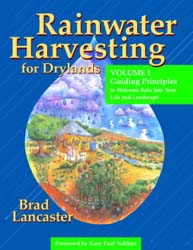Granny's Country Store > Home-Building Resources > Water Collection | Search | View Cart
Rainwater Harvesting for Drylands
Volume 1: Guiding Principles to Welcome Rain into Your Life and Landscape
by Brad Lancaster

Water is such a precious resource, and probably the most valuable commodity in the arid west, yet oddly, desert environments have the most signs to warn about possible flooding. When it rains, the water is channeled off houses into storm drains, and off the landscape into gully washers. But you can turn water scarcity into water abundance by capturing and using rainwater at home.
Rainwater Harvesting for Drylands, Volume 1 is the core of a three-volume guide (under development) on how to conceptualize, design, and implement sustainable water-harvesting systems for your home, landscape, and community. This book enables you to access your on-site resources (rainwater, greywater, topsoil, sun, plants, and more), gives you a diverse array of strategies to maximize their potential, and empowers you with guiding principles to create an integrated, multi-functional, and water-sustainable water-harvesting landscape plan specific to your site and needs. The book is primarily about catching rainwater for use outside your home for watering the garden and landscape.
Rainwater Harvesting for Drylands includes enough stories, illustrations and simple ideas to inspire and educate readers of all capabilities. With creativity, humor, and common sense, Lancaster shows the reader how to put rainwater to use growing food, shading your home, reducing erosion, and improving wildlife habitat. In addition to conserving money and resources while enriching your surroundings, you can create a landscape that is more beautiful and less work and upkeep than you might imagine.
Lancaster's rainwater research was inspired by a Mr. Phirri in Africa, a man who was arrested several times for "stealing water" from his neighbors during the dry season. He grew and harvested vegetables even when no one else could, and his well never ran dry. But he wasn't stealing water, which he had to prove to the judge by showing off his innovative use of rainwater. He became known as "The man who farms water."
Brad Lancaster and his brother learned from Mr. Phirri's work and implemented the techniques in Arizona to see if it worked there. Their experiences helped influence the city of Tucson to adopt new practices to save precious water for its citizens.
Techniques that work in the extreme environment of Tucson may be applied anywhere. The book includes much more than merely putting out barrels to collect rainwater. You will learn to rethink your entire landscape and grading, creating a microenvironment that will nurture itself. Lancaster's common sense is so extraordinary that you may find yourself wondering why you didn't think of it yourself!
Lancaster has a friendly, conversational writing style that makes the book a pleasure to read. The design principles are inspiring and simple to follow, with enough technical information that you won't be left wondering how to proceed. Rainwater is also much better for plants than either city water or well water, which tends to have a high mineral content. Even high-rainfall areas have dry seasons and droughts, and the methods presented in this book will help your landscape thrive with less input from you. Clearly written with more than 40 photos and 115 illustrations. Rainsource Press. 2006. 183 pages. Printed on 50% post-consumer recycled paper.
-Please scroll down the page for the "Add to Order" button.-